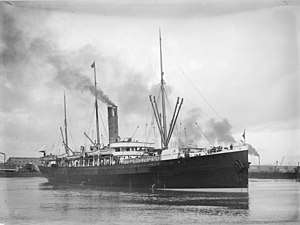SS Warrimoo
SS Warrimoo was an Australian/New Zealand passenger ship, launched in 1892. The ship is best remembered for allegedly crossing the intersection of the International Date Line and the Equator precisely at the turn of the year from 1899 to 1900.
 Warrimoo | |
| History | |
|---|---|
| Name: | SS Warrimoo |
| Owner: |
|
| Port of registry: |
|
| Builder: | Swan Hunter of Wallsend |
| Yard number: | 175 |
| Launched: | May 5, 1892 |
| Completed: | July 1892 |
| In service: | July 1892 |
| Out of service: | May 17, 1918 |
| Identification: | IMO number: 101901 |
| Fate: | Sank after a collision with the Catapulte |
| General characteristics | |
| Type: | Passenger ship |
| Tonnage: |
|
| Length: | 345 ft (105 m) overall |
| Beam: | 42.4 ft (12.9 m) |
| Depth: | 25.1 ft (7.7 m) |
| Depth of hold: | 28 ft (8.5 m) |
| Installed power: |
|
| Propulsion: | Single fixed pitch propeller |
| Speed: | 14.5 kn (26.9 km/h; 16.7 mph) |
It sank in 1918,12 miles SW of La Gallite, in a collision with the French destroyer Catapulte and a resultant explosion of depth charges, while carrying troops between Bizerta and Marseille.[1]
History
It was originally built for James Huddart for Trans-Tasman traffic between Australia and New Zealand, along with a sister ship SS Miowera, and later joined by SS Aorangi. However, it was quickly withdrawn from this route and instead used to provide a service between Canada and Australia using subsidies from both countries. Huddart ran into difficulties after arranging to also call at New Zealand as part of the deal; after he defaulted on payments, the ship was purchased on 16 August 1899 by the New Zealand Shipping Company. In 1901 it was sold on to the Union Steamship company.
In 1914, it was given the role of a troop ship, delivering the first Maori Pioneer military troops to Gallipoli in 1915. It was sold to Tan Kah Kee to become part of the Khiam Yik company in 1916.
On 17 May 1918, as part of a convoy from Bizerta to Marseille, it collided with the French warship Catapulte. During the collision the warship's depth charges became dislodged and detonated in the water, causing ruptures to the Warrimoo and Catapulte. Both ships were lost, along with several lives.
International Date Line story
The ship is most commonly associated with the story of its alleged arrival at the crossing of the International Date Line and the Equator on 31 December 1899 at midnight, under the captaincy of Captain John Phillips.
This resulted in the bow of the ship being in the southern hemisphere in the summer on 1 January 1900, with the stern being in the northern hemisphere in winter on 31 December 1899. The ship was therefore at once within two different seasons, in two different hemispheres, on two different days, in two different months, in two different years, in two different centuries.
The story circulated as early as 1942,[2] and was popularized by John Euller in the magazine Ships and the Sea in 1953.[3] A commonly circulated version is as follows:[4]
The passenger steamer SS Warrimoo was quietly knifing its way through the waters of the mid-Pacific on its way from Vancouver to Australia. The navigator had just finished working out a star fix and brought the master, Captain John Phillips, the result. The Warrimoo's position was latitude 0 degrees x 31 minutes north and longitude 179 degrees x 30 minutes west.
The date was 31 December 1899. Know what this means? First Mate Payton broke in, we're only a few miles from the intersection of the Equator and the International Date Line.
Captain Phillips was prankish enough to take full advantage of the opportunity for achieving the navigational freak of a lifetime. He called his navigators to the bridge to check and double check the ships position. He changed course slightly so as to bear directly on his mark. Then he adjusted the engine speed. The calm weather and clear night worked in his favour. At midnight the Warrimoo lay on the Equator at exactly the point where it crossed the International Date Line!
The consequences of this bizarre position were many. The forward part of the ship was in the Southern Hemisphere and the middle of summer. The stern was in the Northern Hemisphere and in the middle of winter. The date in the aft part of the ship was 31 December 1899. Forward it was 1 January 1900.
This ship was therefore not only in four different hemispheres, two different days, two different months, two different seasons and two different years but in two different centuries-all at the same time.
A contemporaneous newspaper report states that on this trip the Warrimoo crossed the equator earlier, on 30 Dec 1899.[5]
The story may be apocryphal. Whether the ship actually achieved this feat is unknown. Skeptics note that the story did not appear until 40 years after the supposed feat. Furthermore, the navigational technology of the day was likely not accurate enough to have a ship straddle the exact intersection of the date line and equator.[6]
References
- "Tyne Built Ships".
- "In Two Places, at One Time". The Ottawa Journal. 13 May 1942. p. 8. Retrieved December 30, 2018 – via Newspapers.com.
- Euller, John (September 1953). "A freak of navigation". Ships and the Sea. 3. p. 18.
- "Company of Master Mariners of Australia: The Strange story of the SS Warimoo".
- "Arrival of the H.M.S. Warrimoo". The Sydney Morning Herald. 8 January 1900. p. 9. Retrieved December 30, 2018 – via Newspapers.com.
- https://www.snopes.com/fact-check/ss-warrimoo/
External links
- ""Arrival of the S.S. Warrimoo"". The Mercury. Hobart, Tas. 1892-11-10. Retrieved 2019-05-10 – via National Library of Australia.
- "Warrimoo passenger/cargo ship 1892-1918". The Wrecksite.